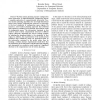Free Online Productivity Tools
i2Speak
i2Symbol
i2OCR
iTex2Img
iWeb2Print
iWeb2Shot
i2Type
iPdf2Split
iPdf2Merge
i2Bopomofo
i2Arabic
i2Style
i2Image
i2PDF
iLatex2Rtf
Sci2ools
ICRA
2005
IEEE
2005
IEEE
Sampling-Based Motion Planning Using Predictive Models
— Robotic motion planning requires configuration space exploration. In high-dimensional configuration spaces, a complete exploration is computationally intractable. Practical motion planning algorithms for such high-dimensional spaces must expend computational resources in proportion to the local complexity of configuration space regions. We propose a novel motion planning approach that addresses this problem by building an incremental, approximate model of configuration space. The information contained in this model is used to direct computational resources to difficult regions, effectively addressing the narrow passage problem by adapting the sampling density to the complexity of that region. In addition, the expressiveness of the model permits predictive edge validations, which are performed based on the information contained in the model rather then by invoking a collision checker. Experimental results show that the exploitation of the information obtained through sampling a...
| Added | 25 Jun 2010 |
| Updated | 25 Jun 2010 |
| Type | Conference |
| Year | 2005 |
| Where | ICRA |
| Authors | Brendan Burns, Oliver Brock |
Comments (0)

